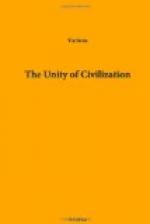The linguistic basis of mediaeval civilization was thus Latin, either in its classical or in its vulgar form. There were of course other languages, and some of these had no small vogue. Just before the period of which we are treating—the period which extends from 1050 to 1300—Icelandic had a wide scope. It might have been heard not only in Scandinavia and the Northern Isles, but in a great part of the British Islands, in Normandy, in Russia—along the river-road that ran to Constantinople—and in Constantinople itself. But the fact remains that the linguistic basis of mediaeval thought and literature was a Latin basis. The Romance University of Paris was the capital of learning: the Romance tongue of Northern France was the tongue of society. And as the linguistic basis of mediaeval civilization was Romance, so, too, was mediaeval civilization itself. The genius of Latin Christianity was the source of its inspiration: the spirit of the Romance peoples was the breath of its being. The souvenir of the old Roman Empire provided the scheme of its political ideas; and the Holy Roman Empire, if a religious consecration had given it a new sanctity, was Roman still. Yet the irruption of the Teutons into the Empire had left its mark; and the emperor of the Middle Ages was always of Teutonic stock. It was perhaps at this point that the unity of the mediaeval scheme betrayed a fatal flaw. It would be futile to urge that the dualism which showed itself in the struggles of papacy and empire had primarily, or even to any considerable extent, a racial basis. Those struggles are struggles of principles rather than of races; they are contentions between a secular and a clerical view of life, rather than between the genius of Rome and the genius of Germany. Hildebrand stood for a free Church—a Church free from secular power because it was controlled by the papacy. Henry IV stood for the right of the secular power to use the clergy for purposes of secular government, and to control the episcopacy as one of the organs of secular administration. But the fact remains that a scheme which rested on a Teutonic emperor and a Roman pontiff was already a thing internally discordant, before these other and deeper dissensions appeared to increase the discord.




